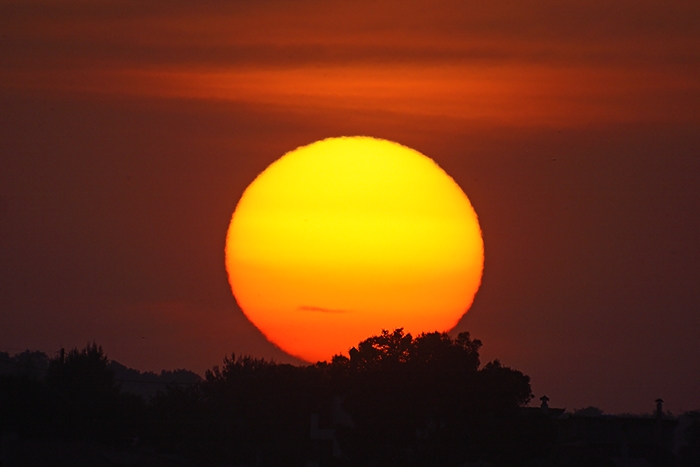
A common misconception is that the sun is larger when it is near the horizon than when it is high overhead. However, this optical illusion is
not true, for the apparent size of the sun is virtually the same when it is rising or setting near the horizon or when viewed overhead (in
fact, it is very slightly smaller when viewed near the horizon due to refraction as well as the greater added distance in observing across the
earth's radius). This illusion has been wrongly attributed to landmarks near the horizon, such as homes and trees, supposedly giving a sense
of perspective and whereas the same perspective is lost when looking at the overhead sun bathed in an empty sky. As noted by
Donald E. Simanek and
Carl J. Wenning, the real reason behind this trick by our brain is
the perception of the sun (or moon) being against a "close" or "distant" foreground and which is lucidly described by the above two references.
However, if we were approach the apparent size of the sun methodically by studying it during perihelion and aphelion, we can detect a small
change using photographic equipment thanks to the elliptical orbit of our planet around the sun which leads to variations in distance (and
apparent size) of the order of about 3.4%. More specifically, at perihelion each January, earth is approximately 147 million km away from sun
whose apparent diameter is about 32.53' whereas, at aphelion each July, earth is approximately 152 million km away and the sun is characterized
with an apparent diameter of about 31.46'. This difference of 5 million km between perihelion and aphelion leads to the slight change in the
apparent diameter of the sun as illustrated by two images of the sun captured six months apart when the sun was near its minimum possible
perihelion (Jan 2/2005) and maximum possible aphelion (Jul 5/2005) and while crossing the local meridian and which are presented
here.
Note: Following the eruption of the Eyjafjallajokull volcano near Reykjavik, Iceland with billows of smoke drifting
across (northern) Europe and which caused numerous flight delays and cancellations, the opportunity was used to carefully pursue the setting sun
since volcanic ash can lead to very dramatic sunsets. The image below was taken a few kilometers from the seaside resort area of Oropos northeast
of Athens and whose history dates to the time of the golden age of ancient Greece. The foreground evergreens (and homes barely visible) lie atop
a hill at an altitude of approximately 35 meters (100 feet). The photo was taken from a distance of 640 meters away to the east of the setting sun
so as to yield a reasonable balance in the aspect ratio involving the foreground evergreens and the setting sun.
A very dramatic setting sun against a distant summer home was captured a few days earlier from the same distance and shooting location (see
here).
Note: For additional photos of the sun and/or full moon against other well-known Greek archaeological grounds and
sites, please click here.
|
Body: Sun Mass: 332,900 x Earth Mean Eq Diameter: 109.1 x Earth R.A / Dec: 01h 34m 58s / 08° 27' 06" Distance: 150 million km Diameter: 31.88 ' Magnitude: -26.8 |
 |
Date: Apr 15, 2010 19:52:50 UT+3 Location: Oropos, Greece Equipment: Takahashi FSQ-106/f5 TeleVue 2x Big Barlow Canon EOS 5D Mk I Baader UV/IR-Cut Filter Exposure: 1 x 1/800 sec ISO 100 RAW Image Format 4368x2912 Image Size Manual Mode Software: Digital Photo Pro V1.6.1.0 Photoshop CS2 Processing: RAW to TIFF (16-bit) conv Resampling (19%) JPG Compression |